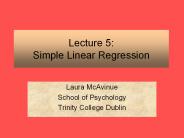Previous lecture - PowerPoint PPT Presentation
1 / 15
Title:
Previous lecture
Description:
Use an existing crypto library for the block cipher, but implement the chaining yourself! Examples of possible crypto libraries to use: openssl (for C) or JSSE ... – PowerPoint PPT presentation
Number of Views:22
Avg rating:3.0/5.0
Title: Previous lecture
1
Previous lecture
- Practical things about the course.
- Example of cryptosystem substitution cipher.
- Symmetric vs. asymmetric cryptography.
- RSA keys, encryption, decryption. (Proof of
correctness not part of course.)
2
This lecture
- Block ciphers
- Modes of operations
- First assignment
- Hash functions
3
Block ciphers
- A block cipher B is an encryption function
Ekey0,1k ? 0,1l and a decryption function
Dkey0,1l ? 0,1k such that Dkey(Ekey(m)) m. - The value k is called block length. Usually k
l. - Commonly used block ciphers include DES, 3DES and
IDEA.
Clear (plain) text
Cipher text
Key
4
Chaining ciphers
- What happens when the clear text is longer than
the block length k? - Most simple solution encrypt each block
separately. - This mode is called ECB, Electronic Code Book
Clear text
Enc
Enc
Enc
Enc
Key
Cipher text
5
Problems with ECB
- The main problem with ECB is that an adversary
can change order or remove blocks without
detection. - The solution link the encrypted blocks to each
other. - Most common option Cipher Block Chaining, CBC
6
Cipher Block Chaining
- A feedback is introduced to link the blocks
together
Clear text
IV
Enc
Enc
Enc
Enc
Key
Cipher text
7
Cipher Block Chaining, cont.
- Let Ekey be the encryption function, Dkey be the
decryption function, Pi block i of the clear text
and Ci block i of the cipher text, i 1, 2, 3...
- Encryption of block i Ci Ekey(Pi ? Ci-1) where
C0 IV (initialization vector) - Decryption of block i Pi Ci-1 ? Dkey(Ci)
- The Initialization Vector, IV C0, must be known
to both parties and can be sent in clear.
8
First assignment
- Implement encryption and decryption using your
favourite block cipher (DES, 3DES, IDEA etc) for
two modes (e.g., ECB and CBC) with a usable (not
necessarily user-friendly!) command-line
interface. - Use an existing crypto library for the block
cipher, but implement the chaining yourself! - Examples of possible crypto libraries to use
openssl (for C) or JSSE (for Java). - You can get a maximum of 20 points for the exam
from this assignment.
9
Rules for the assignment
- Choose your favourite language!
- If you pick another language than C, C, Pascal
or Java, or another platform than UNIX/Linux or
Windows/DOS, please contact me first! - Solve the assignment either individually or in
pairs. - Hand in the solution no later than March 5th. You
lose one point per day if you hand in late. You
can hand in your solution - By email to marten_at_nada.kth.se.
- On a diskette at the lecture
- As a link to a site that I can reach
10
Rules for the assignment, cont.
- Please include
- source code
- executable
- a brief description of the interface (just enough
so that I can run it) - contact information
- the amount of time you spent on the assignment
(not used for grading, just to tune the
difficulty of the assignments)
11
Rules for the assignment, cont.
- Co-operation between groups is allowed only on a
conceptual level - Example of things you may discuss Is it easier
to solve the assignment in Java than C? What is a
good format to provide the key? Is this input
format reasonable? - Example of things you may not discuss Please
show me your code so I can copy part of it! - Please state the persons you have discussed the
solution with. - You may be asked to explain your solution orally.
12
Hash functions
- A hash function computes a fixed length value
from a variable length source - Example Check sums in communication protocols
- Indices in databases
- More convenient to handle a hash of a document
instead of the document itself - We will consider cryptographically secure hash
functions.
13
Hash functions, definition
- A hash function is a function f0,1 ? 0,1n.
- The size of the output, n, is a property of the
function. Common values are 128, 160 and 256. - Commonly used hash functions are MD5, SHA and
SHA-1
14
Hash function examples
- f(m) first 40 bits of m
- f(m) last 40 bits of m
- f(m) XOR of the bytes of m
15
Properties of good hash functions
- Let H be a hash function
- One-way
- Given x, unfeasible to compute an v such that
H(v) x - Collision-free
- Unfeasible to find x1 and x2 such that H(x1)
H(x2) and x1 ? x2































